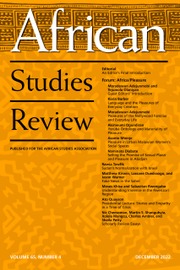A History of Rwanda from the Monarchy to Post-genocidal Justice stands as a pivotal scholarly work that delves deeply into the intricate and tumultuous history of Rwanda, spanning from its precolonial monarchy through colonial rule and into the aftermath of the 1994 genocide. The author provides a rigorously researched account that moves beyond established narratives of ethnic strife to illuminate the complex historical, sociopolitical, and cultural dynamics that have shaped modern Rwanda. By challenging the reductionist view of the genocide as an inevitable result of ethnic tensions, the book serves to enrich both academic discourse and general understanding of this multifaceted history, making it an invaluable resource for scholars, students, and the interested general reader alike.
This book has a good number of strengths across its seven chapters. One of the foremost strengths of the book is its critical perspective, effectively interrogating existing historiographical biases. The narrative does not shy away from addressing long-held assumptions that view the genocide as a natural outgrowth of historical ethnic divisions. Instead, the author presents a more nuanced understanding of Rwanda’s history, revealing paths not taken and emphasizing the sociopolitical complexities that defy simplification.
The author’s extensive research greatly enhances the work’s credibility. By integrating a rich array of sources—ranging from colonial documents to recent analyses—the book offers a comprehensive examination that spans multiple periods and events. This wealth of material underlines the author’s dedication to producing a well-rounded historical account.
Moreover, the book demonstrates conceptual clarity in explicating complex ideas such as ethnicity, political power, and social structure within Rwanda. Such clarity is commendable, particularly as it allows readers who may not possess a specialized background in historical studies to engage meaningfully with the text.
Another notable strength lies in the author’s interdisciplinary approach, especially in Chapter Four, which draws insights from anthropology, history, and political science. This expansive scope not only enriches the narrative but also highlights the interconnectedness of cultural and political phenomena, thereby broadening the landscape of Rwandan studies and inviting further interdisciplinary enquiries.
Among the various sections, Chapter One serves as a significant contribution to knowledge. It critically examines the foundations of the Abanyiginya monarchy, debunking the traditional view that equates monarchical continuity with unqualified political stability. By focusing on the dynamics of governance and cultural paradigms, this chapter enhances our understanding of the sociopolitical landscape that characterizes Rwanda, making it particularly informative for historians and political scientists.
Despite its many strengths, the book is not without its flaws. One notable weakness is the neglect of certain groups, particularly the Abatwa, in Chapter Four (116–19), the smallest ethnic group in Rwanda. Although the author makes substantial efforts to explore various historical narratives, a more extensive examination of the Abatwa’s historical significance would undoubtedly enrich the book’s portrayal of Rwanda’s diverse societal landscape.
Moreover, the book sometimes suffers from overly academic language. While the scholarly tone lends the work authenticity, it may alienate general readers unfamiliar with dense academic discourse. Striking a balance between depth and accessibility would broaden the work’s potential readership.
Additionally, there is an absence of first-person narratives or oral histories in the book, which could provide emotional resonance and personal insights into the experiences of Rwandans during pivotal historical moments. The inclusion of such voices would deepen the reader’s connection to the material and enhance the narrative’s impact.
Moving forward, the book could benefit from a broader scope of minority voices. Greater attention to women and other marginalized groups in Rwandan history would help present a fuller picture of the sociopolitical realities in the country. Similarly, incorporating regional comparisons with other East African nations could provide a richer contextual understanding of Rwanda’s historical and contemporary struggles.
The text would also benefit from incorporating discussions on current events, particularly regarding Rwanda’s political landscape and social justice initiatives postgenocide. A chapter dedicated to contemporary issues would not only modernize the historical narrative but also elevate the book’s relevance for readers interested in ongoing developments within Rwanda.
In conclusion, A History of Rwanda from the Monarchy to Post-genocidal Justice is an essential scholarly publication that offers a thoughtful exploration of Rwanda’s rich, albeit tragic, history. Although the book excels in critical historiography and thorough analysis, integrating broader voices and perspectives would amplify its impact. The author’s commitment to unveiling the complexities of Rwandan history makes this book a compelling read for anyone seeking to understand the interplay of historical narratives that continue to shape modern Rwanda. Despite its shortcomings, this work is highly recommended for scholars, students, and anyone with a keen interest in African history, particularly those striving to grasp the complexity of one of Africa’s most challenging yet intriguing histories.

